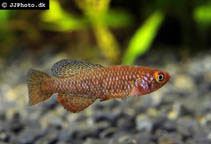| Family: |
Nothobranchiidae (African rivulines) |
| Max. size: |
4.49 cm TL (male/unsexed); 3.89 cm TL (female) |
| Environment: |
pelagic; freshwater |
| Distribution: |
Africa: Luapula River system (upper Congo River basin) in Zambia (Ref. 53985). |
| Diagnosis: |
Dorsal soft rays (total): 15-17; Anal soft rays: 16-17. Diagnosis: This species is distinguished from its congeners by the following combination of unique characters: 15-17 dorsal fin rays; 16-17 anal fin rays; male coloration with irregular red reticulation contrasting with light blue background color on the entire body. The frontal and superior portion of the head red; anal fin with a red distal part. The caudal fin base is red spotted, with distal part transparent light blue. The anterior part of base of dorsal fin has distinct black spots and hardly visible papillae. Sides of female are not marked like the males, but with narrow brown scale margins (Ref. 53985).
Description: The species is deep-bodied, with rounded snout and a terminal mouth directed upward. The scales on median longitudinal row 28-30 + 2-4 on caudal fin base. Variable pattern of cephalic scalation, although most specimens studied show G-type. The anterior neuromast series of 'open' type; central series in two shallow grooves, lined with low lobes. Posterior cephalic neuromast series in curved shallow pits on each side. Preopercular neuromast system in open groove, with distal ridge slightly overlapping the opercle.
Male body laterally compressed; dorsal profile convex between snout and beginning of dorsal fin: in older males dorsal profile slightly concave on supraoccipital area; all unpaired fins are rounded, dorsal and anal fin present small papillate contact organs; opercular membrane is projecting from opercle, distal edge slightly wrinkled. Females are smaller than males, the maximum size observed is 38.9 mm TL; its body less compressed and less deep; dorsal and caudal fin rounded, anal fin triangular with tip rounded; anal fin positioned more posteriorly than in the male; no papillate contact organs on dorsal and anal fin; opercular membrane not projecting from the opercle. (Ref. 53985). |
| Biology: |
Populations of this species have been found scattered over a large area in the Luapula River basin; specimens have been found mainly in shallow and vegetated parts of small, slow-flowing rivers which empty into swamps; the species was also collected from so-called "dembos" or water-filled depressions; all habitats were temporary and only filled with water during the wet season and for a short period afterwards, the bottom substrate of which were usually silt or clay with a high humus content (Ref. 53985). |
| IUCN Red List Status: |
Vulnerable (VU); Date assessed: 08 January 2019 (B1ab(iii)) Ref. (130435)
|
| Threat to humans: |
harmless |
Source and more info: www.fishbase.org. For personal, classroom, and other internal use only. Not for publication.

